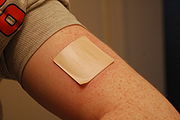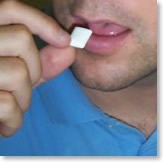
Nicotine replacement therapy
Encyclopedia

Nicotine
Nicotine is an alkaloid found in the nightshade family of plants that constitutes approximately 0.6–3.0% of the dry weight of tobacco, with biosynthesis taking place in the roots and accumulation occurring in the leaves...
to the body by means other than tobacco
Tobacco
Tobacco is an agricultural product processed from the leaves of plants in the genus Nicotiana. It can be consumed, used as a pesticide and, in the form of nicotine tartrate, used in some medicines...
, usually as part of smoking cessation
Smoking cessation
Smoking cessation is the process of discontinuing the practice of inhaling a smoked substance. This article focuses exclusively on cessation of tobacco smoking; however, the methods described may apply to cessation of smoking other substances that can be difficult to stop using due to the...
. Common forms of nicotine replacement therapy are nicotine patch
Nicotine patch
A nicotine patch is a transdermal patch that releases nicotine into the body through the skin. It is used as an aid in nicotine replacement therapy , a process for smoking cessation. The first published study of the pharmacokinetics of a transdermal nicotine patch in humans was authored by Jed E....
es (which transdermally administers nicotine) and nicotine gum
Nicotine gum
Nicotine gum is a type of chewing gum that delivers nicotine to the body. It is used as an aid in nicotine replacement therapy , a process for smoking cessation and quitting smokeless tobacco. The nicotine is delivered to the bloodstream via absorption by the tissues of the mouth.It is currently...
(which orally administers nicotine). The primary benefit of nicotine replacement therapy is that it prevents cravings in a smoker whilst allowing them to abstain from tobacco—and thus avoid the harmful effects of smoking. NRT enables the easier overcoming of nicotine addiction because it reduces the craving to smoke. The incidence of smoking after the use of nicotine replacement therapy is 1.5–2 times less than when therapy is not used.
Forms

Nicotine patch
A nicotine patch is a transdermal patch that releases nicotine into the body through the skin. It is used as an aid in nicotine replacement therapy , a process for smoking cessation. The first published study of the pharmacokinetics of a transdermal nicotine patch in humans was authored by Jed E....
es are a transdermal patch
Transdermal patch
A transdermal patch is a medicated adhesive patch that is placed on the skin to deliver a specific dose of medication through the skin and into the bloodstream. Often, this promotes healing to an injured area of the body. An advantage of a transdermal drug delivery route over other types of...
for the administration of nicotine. Nicotine gum
Nicotine gum
Nicotine gum is a type of chewing gum that delivers nicotine to the body. It is used as an aid in nicotine replacement therapy , a process for smoking cessation and quitting smokeless tobacco. The nicotine is delivered to the bloodstream via absorption by the tissues of the mouth.It is currently...
, nicotine sprays, nicotine sublingual
Sublingual
Sublingual, literally 'under the tongue', from Latin, refers to the pharmacological route of administration by which drugs diffuse into the blood through tissues under the tongue...
tablets, and nicotine lozenge
Nicotine lozenge
A nicotine lozenge is a tablet that contains a dose of nicotine which dissolves slowly in the mouth to release the nicotine. The nicotine is absorbed through the lining of the mouth and enters the blood vessels...
s administer nicotine orally. Nicotine inhalers are metered-dose inhaler that administer nicotine through the lungs;
Snus
Snus
Snus , or Swedish snuff, is a moist powder tobacco product originated from a variant of dry snuff in the early 19th century in Sweden, consumed by placing it under the lip for extended periods of time. The precursor of snus, the dry form of snuff inhaled through the nose, was introduced in Europe...
and nasal snuff also allow for nicotine administration outside of tobacco smoking, but do cause negative health effects.
Cost
Another concern relates to the fact that people may become addicted to the NRT product and turn back to tobacco products to save money. Typically, the cost of NRT lasting seven days is up to £20 over the counter, whether spray, gum or inhaler, as against £4 to £6 for twenty tax paid cigarettes, or £3 for tax paid rolling tobacco. The cost of cigarettes or tobacco over the same period varies depending on the smoker, while the cost of NRT remains static regardless of the level of nicotine it contains. This leads to the relative cost of NRT versus cigarettes or tobacco being dependant on how much the individual smokes. The British NHSNational Health Service
The National Health Service is the shared name of three of the four publicly funded healthcare systems in the United Kingdom. They provide a comprehensive range of health services, the vast majority of which are free at the point of use to residents of the United Kingdom...
provides help in the form of prescriptions, reducing the cost to £7.40 per script, and if several products are included on one script then the price will drop well below that of actual cigarettes.
Exempted populations
Evaluation of NRT in real-world studies produces much more modest outcomes than efficacy studies conducted by the industry-funded trials. The National Health ServiceNational Health Service
The National Health Service is the shared name of three of the four publicly funded healthcare systems in the United Kingdom. They provide a comprehensive range of health services, the vast majority of which are free at the point of use to residents of the United Kingdom...
(NHS) in England has a smoking cessation service based on pharmacotherapy in combination with counseling support. An ASH report claims that the average cost per life year gained for every smoker successfully treated by these services is less than £1,000, below the NICE guidelines of £20,000 per QALY (quality-adjusted life year). However, the investment in NHS stop smoking services is relatively low. A comparison with treatment costs for illicit drug users shows that £585 million is committed for 350,000 problem drug users compared to £56 million for 9 million users of tobacco. This is £6.20 for each smoker, compared to £1,670 per illegal drug user (Action on Smoking & Health, 2008).
Disappointingly, the claims for high efficacy and cost-effectiveness of NRT have not been substantiated in real-world effectiveness studies. Pierce and Gilpin (2002) stated their conclusion as follows: “Since becoming available over the counter, NRT appears no longer effective in increasing long-term successful cessation” (p. 1260). Efficacy studies, which are conducted using randomized controlled trials, do not transfer very well to real-world effectiveness. Bauld, Bell, McCullough, Richardson and Greaves (2009) reviewed 20 studies the effectiveness of intensive NHS treatments for smoking cessation published between 1990 and 2007. Quit rates showed a dramatic decrease between 4-weeks and one year. A quit rate of 53% at four weeks fell to only 15% at 1 year. Younger smokers, females, pregnant smokers and more deprived smokers had lower quit rates than other groups.
Trade names
Trade names include NicoretteNicorette
Nicorette is the brand name of a pharmaceutical preparation that contains nicotine for the treatment of tobacco dependence. Nicorette was the first medicinal preparation to facilitate smoking cessation....
, Nicoderm
Nicoderm
NicoDerm, also known as NicoDerm CQ is a branded over the counter palliative nicotine replacement therapy used to minimize the withdrawal effects involved in quitting smoking....
, Nicotinell and Commit Lozenge.
See also
- Nicotine addiction
- Tobacco smokingTobacco smokingTobacco smoking is the practice where tobacco is burned and the resulting smoke is inhaled. The practice may have begun as early as 5000–3000 BCE. Tobacco was introduced to Eurasia in the late 16th century where it followed common trade routes...
- Smoking cessationSmoking cessationSmoking cessation is the process of discontinuing the practice of inhaling a smoked substance. This article focuses exclusively on cessation of tobacco smoking; however, the methods described may apply to cessation of smoking other substances that can be difficult to stop using due to the...
- Tobacco cessation clinicTobacco cessation clinicTobacco Cessation Clinic is an initiative by the World Health Organization and the Ministry of Health of India. Tobacco cessation activities formally began with the opening of 13 tobacco cessation clinics in Anand, Bhopal, Bangalore, Chandigarh, Chennai, Cuttack, Delhi , Goa, Jaipur, Lucknow,...
- American Legacy FoundationAmerican Legacy FoundationThe American Legacy Foundation is a 501 not-for-profit organization dedicated to preventing teen smoking and encouraging smokers to quit. It was established in March 1998 as a result of the Master Settlement Agreement between a coalition of attorneys general in 46 states and five United States...

